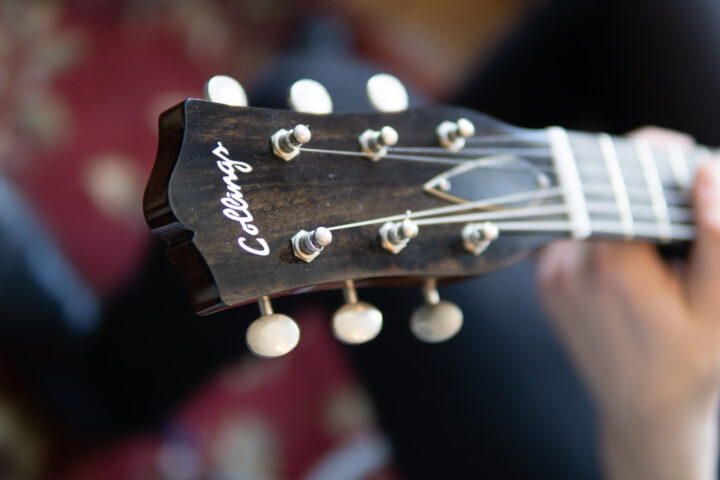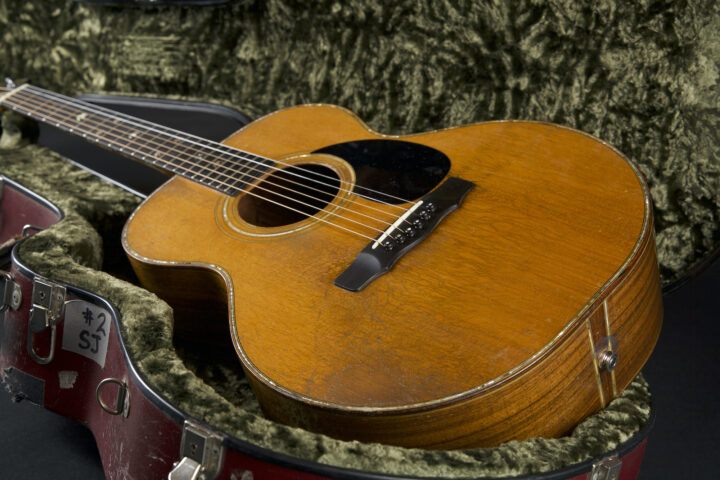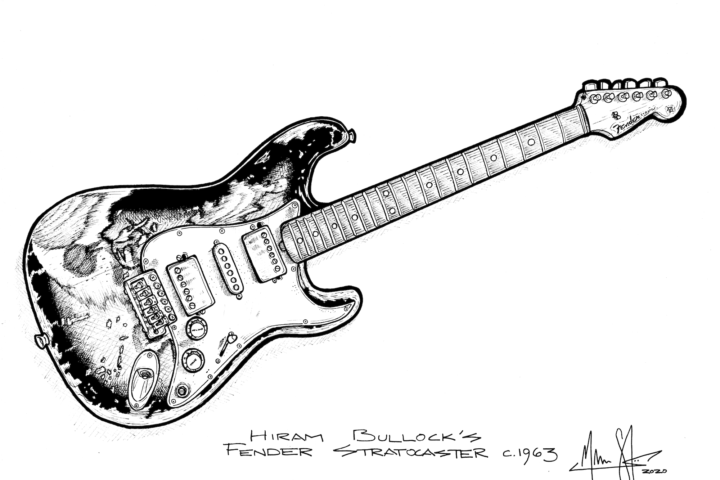Editor’s Note: This story originally ran in the Fretboard Journal’s second Electric Guitar Annual. Digital copies of the complete issue, with additional photos, can still be purchased for download.
A few years after a rock star passes, it’s not uncommon for their instruments to find their way to a famous auction house. At that auction, you tend to see some usual suspects: a few iconic old Fenders or Gibsons that will fetch six figures; plenty of new, factory-made guitars that were probably freebies; an oddball European instrument or two; maybe a handful of acoustics. But Walter Becker wasn’t your typical guitar hero. For decades, the reclusive Steely Dan co-founder – who famously shied away from interviews, letting his complicated guitar-playing speak for itself – was quietly amassing and using dozens, make that hundreds, of luthier-built instruments, amps and pedals.
To those craftspeople, Becker was a patron of the highest order (typically buying off the shelf, always insisting on paying full price). His prodigious appetite for new gear helped at least a couple independent builders find a footing in the notoriously tough marketplace. On October 17 and 18, 2019, over a thousand of Becker’s instruments were auctioned off at Julien’s. Interestingly, one of the most heated auctions wasn’t for a vintage instrument butratherfor his green Chihoe Hahn-built Strat-style guitar. That one fetched over $68,000.
What follows is a brief oral history from a few of the many builders Becker championed over the years: Roger Sadowsky, Hahn, Doug Kauer, Steve Grimes, Ian Anderson and Adam Grimm (Satellite Amplifiers). To fill in the gaps, we also reached out to Nite Bob, the legendary rock & roll character who served as Becker’s guitar tech and de facto buying guide for the last decade. Together their recollections shed a new light on Becker’s unique personality, his passion for gear and his love for experimentation.
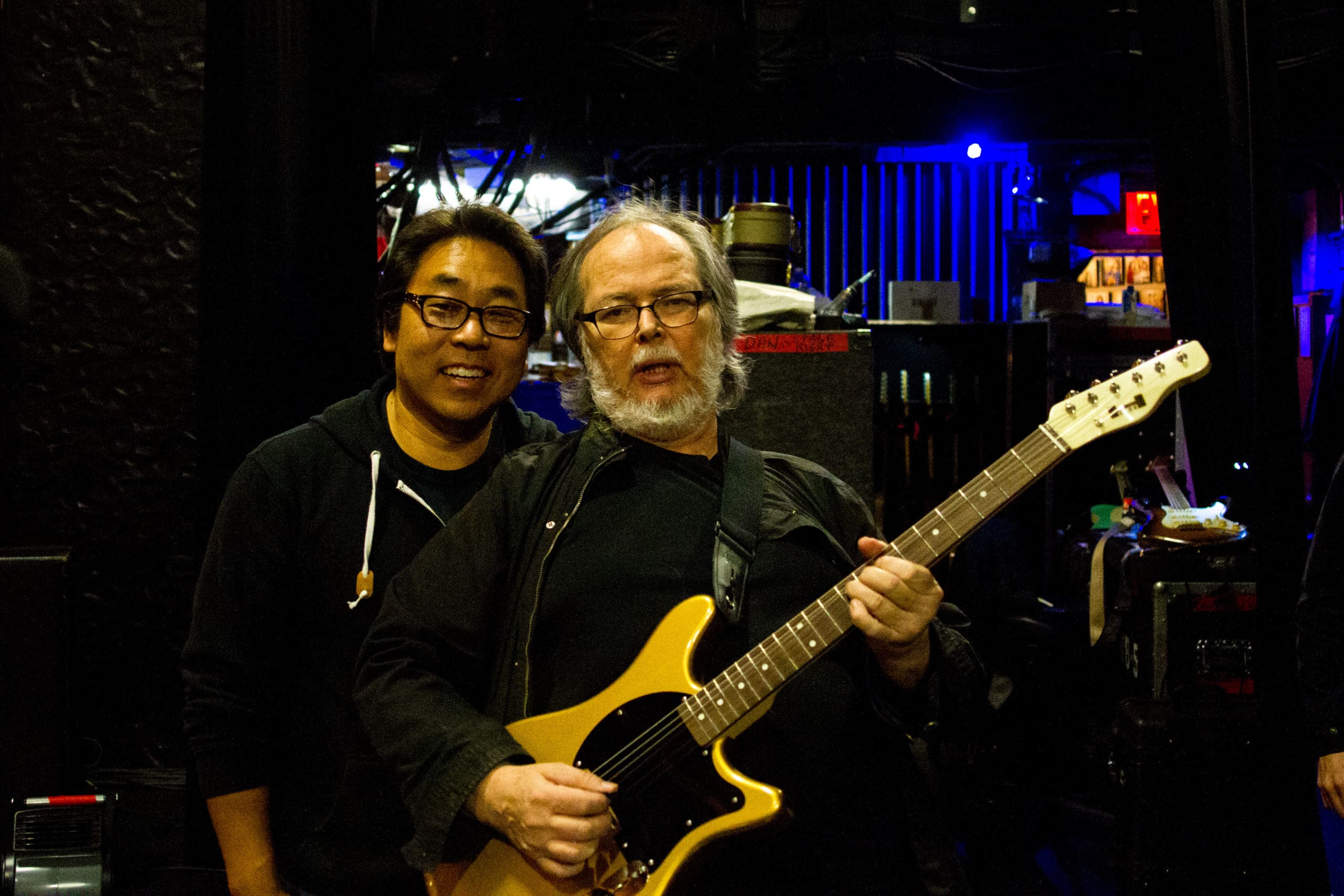
Above: Chihoe Hahn and Walter Becker, courtesy Hahn Guitars.
First Encounters
Steve Grimes: I built this archtop guitar for a guy named Richard Chamberlain. Not the Richard Chamberlain, but this Richard Chamberlain was a really good jazz player who lived here in Maui. He ordered a guitar from me and said, “I want a pickup on it.” I said, “Just so you know, I make acoustic archtops, they’re very acoustic, and if you put a humbucker pickup on it, you can have feedback problems if you sit in front of an amp.” And he said, “No.” I said, “Do you want me to make it acoustic,or I can also make a nice plain guitar, make it less acoustic, make the top thicker, whatever you need, you know, we need to do?” And he goes, “No, I want it acoustic.”
So I made this guitar and then a month later he called me and goes, “This is not working.” I thought something was wrong with the guitar and, and for him it was, it was too acoustic, it was tooloud. So I ended up buying that guitar back from Richard. At the time [1983], one day a week I would go down to this music store on Maui and do their repairs. One day, Walter walked in,and they had let me put this guitar that I bought back up on the wall. He was playing it and we got into a conversation and he ended up buying it. That was the first guitar that he bought: It still said RHC inlaid on the peg head, so I had to get rid of that, the [original] guy’s initials. That became one of Walter’s go-to guitars,and then that started a string of various instruments. I made him a koa-chambered Strat, in maybe ’85 or ’86, I made him a half-size guitar, what I call a Tiny Grimes—named after the famous Tiny Grimes—but mostly he was in interested in archtops.
Roger Sadowsky: Walter started coming to my shop on an infrequent basis. He was very low-key. I think this was around ’91. He would just take instruments, go into my little sound room at the time and noodle around. He would make jokes that he was in a 12-step program for guitarists and that he needed to sell one in order to buy a new one.
The first instrument he bought from me was a candy-apple-red Strat with a rosewood board. He used it on the first Steely Dan tour, which I think was in ’92. That was the start. And he started stopping in regularly. By that time, I discovered that in addition to his Hawaii residence, he had an apartment in Manhattan.
Chihoe Hahn: [The first order]was quite a while ago. Doug Myer is a good friend of mine; he’s at Mountain Cat Guitars. He introduced me to NiteBob, who probably is the main character in this story. I got a guitar to Nite Bob, a 1229, which was the first variant of a Tele that I had made. It’s a thin-bodymahogany Tele. And they got the guitar out to Walter while he was on tour. It might have been like 2012 or something, a long time ago. Walter loved it and started ordering guitars on tour. I would just send them to various Four Seasons Hotels as they were touring.
Adam Grimm: We were doing one of the amp shows in New York. There was a store that had carried our stuff called BCR Music & Sound, out in Lemoyne, Pennsylvania. That guy had known Nite Bob and suggested that we go to that amp show. So Nite Bob and Doug Meyer from Mountain Cat Guitars showed up at the New York amp show and walked into my room and really liked my stuff. I knew who Nite Bob was, but I had never met him before. He’s an underground name: People on the inside know who he is, people on the outside are like, “Why is an adult man named Nite Bob?”
[Nite Bob] was working for Becker at the time; he told Becker about me. A couple of months later, we were doing a different show in Nashville, and we had just found out that Mike McCready had bought some [Satellite amps] for Pearl Jam, so I was extremely happy that day. I get a call from Nite Bob:“We’re also in Nashville. Bring an amp over. You have half an hour to get here.”
I grabbed the nearest one, hopped in a carand [drove] over to sound check. They were just stepping off the stage right when we got there; they sound checked early. I thought we missed the opportunity. Nite Bob goes, “No, no, wait here. Don’t go anywhere.” About 10 minutes later, he comes back out and says, “This is Walter.” [Walter] takes the amp, walks up on the stage and sound checks with the band. And he went through probably 15 or 20 guitars. He tried all kinds of stuff. I’m just there, getting a private Steely Dan show,which I’m just thrilled about. He walks offstage, says, “Nice to meet you,” and wanders off and that’s it.
And then Nite Bob says again, “Don’t go anywhere.” After five or 10 minutes, he goes, “All right, come on back.” And so I sat down and started talking to Walter about all kinds of different things, basses and amplifiers and the world in general… The Honeymooners, Forbidden Planet. His mind would follow paths of thought and he’d just go with them.
He said, “I really like the amp, but I don’t really know how it’s going to work out with everything. Can I just borrow it?” I said, “Sure.” Hesaid, “If I want it, I’m going to pay for it. I don’t want a discount. I don’t want anything like that. I just want to try it out for a little bit.” I’m like, if Walter Becker wants to take an amp, I trust him, go right ahead. He bought that one and then he bought another one and then he bought another one.
Ian Anderson: He bought one of my guitars used from a shop in North Carolina, The Amp House. Chris was a dealer of mine and I turned Chris on to this guitar. One of my customers had to sell it for financial reasons. Really great guitar. Walter bought it and he just absolutely loved it.
It was his favorite guitar that he ever owned except for an old Les Paul that he liked. It was really funny because that guitar was so special to him, he would never play it outside of a gig; he would save it for the show.
It was the one you see in Rolling Stone, my standard model, which is basically a Les Paul, carved maple top with Honduras mahogany neck and body and a Brazilian rosewood fretboard.
More Orders
Roger Sadowsky: In the beginning, he was just buying instruments that I had on the wall, including basses, but then he started ordering stuff from me. It eventually led to us doing the Walter Becker model together. This is the mid-2000s. I had a very wonderful and pleasant relationship with Walter for many years.
Ian Anderson: He had about 10 or 12 of my guitars that he bought from me directly or used after that, but that [first Les Paul-style] was always his favorite. He’d always ask me, “Is this—is this guitar going to be as good as Number One?” And I’d just say, “I don’t know. They’re all good.” But he bonded with that one,it was his favorite.
Steve Grimes: His second [order] was the koa chambered Strat. I said, “If I make it out of solid koa it’s going to be too heavy.” He agreed with that; it was this really outrageously beautiful curly koa. I forget what kind of pickups that I put on it, but he would bring all these guitars for me to fix or modify. He was very fickle with his guitars; his favorite for a while was a James Tyler. But he would bring the Strat up and he’d say, I want to be able to have the neck pickup and the bridge pickup on at the same time without the middle. Can you wire it that way?
“Uh, sure, Walter,” I’d say. And then also, can you have another switch that makes all three of them on at the same time? “Okay,” I said. So I took these guitars and would modify them to have these extra switches that would give him every possible pickup configuration. We must have tried a dozen different bridges, and I was constantly doing modifications on his guitars that other people built.
Nite Bob: He loved to shop, man. He was every guitar-shop-owner’s dream. Unlimited budget, you know. If he came to your store, usually it was 15 minutes before closing. Because he didn’t like people to bug him when he was trying to do things. And you would stay two or three hours after closing. And it could be a $1,000 sale, it could be a $15,000 sale. He loved going to vintage shops all over the place. He loved Emerald City Guitars in Seattle. He liked going to Rock and Roll Vintage, and Chicago Music Exchange in Chicago. Buzzy, we’d go into Buzzy [Lark Street Music] all the time. They loved us there. He bought a whole bunch of Bacon & Day stuff.
He had to have 20 lap steels. He didn’t even know how to hold the bar. He’d say, “One day, I’m gonna learn how to play this!”
Ian Anderson: He was always in touch. If I ever had anything that wasn’t sold and I thought it was right for him, I’d call him up. He’d be like, “Yeah, send it to me!” He was really a great supporter and enthusiastic.
Adam Grimm: There was one time where I was out there and he said, “Why don’t you ever make any amplifiers with big bottle tubes or anything?” I said, “Well, I have, but the ones I want to use are vintage KT66s and they’re extremely expensive and nobody wants to pay for them because they don’t understand why they’re so good…but they are my favorite tubes ever.”
He said, “Well, how expensive are they?” I said, “Well, a good pair of vintage KT66s is about 500 bucks.” He said, “I’ll do it. Build the amp.” I said, “Okay, great.”
So I built the amp and sent it to him and he loved it. That was the one that he played at every single one of the shows from that point on. He always had at least one Satellite up there, but that one was the one that was always there. Sometimes there were three. Sometimes there were six. I think he owned 10 or 11 of them; that’s what became our Cuda model.
An Ear for Subtleties
Steve Grimes: He had an ear for subtleties in a different way than I do, I have an ear for subtleties in voicing sound boards, but he could hear the difference between the neck and bridge pickup being on with the middle being off and then with all three of them on. I’d go down to his house and he’d be playing through a Dumble amp and he’d say, Now listen to this! He had such a refined ear for tone. The value of what I was doing sometimes was lost on me,but I understood that it meant a lot to him.
Adam Grimm: I can explain the intricacies of an amplifier and how things work in terms that people who are not engineers can understand. When people come to me with an idea and say, “I have this sonic picture in my head that I don’t have words to describe, but I’m going to try and describe it to you,” I can try and put that into an end product to get them what they’re looking for.
I would get phone calls from Nite Bob saying, “Walter wants to talk to you.” He’d hand the phone to Walter and we would discuss all the different things about speaker cones and why this magnet over that magnet. It wasn’t always speakers, it would be why different parts of things make a difference. He would do a lot of research on things, on any subject he was interested in.
There’s a band called Social Distortion, they were one of the first people that ever played [Satellite] stuff. [Guitarist] Jonny 2 Bags is a good friend of mine. He’s got the third amp I ever made and the fifth amp and quite a few others. He’s been playing them since 2005. I was going to the East Coast for Christmas and I got a call that they were going to have a Christmas party out at Mountain Cat Guitars and that Nite Bob and Walter were going to be there. I go out there and it’s Doug, who owns Mountain Cat, and Nite Bob and Walter and me. That was the Christmas party. We had a lovely party. It was a delightful time.
This was probably the fourth or fifth time I’d ever hung out with him and Walter starts playing a Vandals tune. They were an Orange County punk rock band who had a song about Johnny 2 Bags called, “Johnny Twobags doesn’t have the blues…” It’s basically about how his upbringing isn’t bad enough for him to be able to play the blues. It’s all comedy.
Walter started playing this Vandals tune! He was interested in what I did. He went and read everything he possibly could, watched videos of everybody, and had immersed himself in the world of Satellite Amplifiers.
Nite Bob: We had cable showdowns that were unbelievable. The more expensive the cables were, the faster they broke. That’s the thing I found out. He was a hi-fi guy, too.
Extreme Lengths
Nite Bob: People who look at Walter Becker as a jazz guy wouldn’t understand that when we were out, he watched The Who Live at the Isle of Wright. We started this thing called the 30-watt rule: No amps onstage were to be louder than 30 watts. SteelyDan is very quiet. All of a sudden, this 100-watt Hiwatt setup shows up. What he’d do is just blast it in the afternoon. He just wanted to know “How did [the Who] get that sound?” We used to play in the hallways of SIR, just cranking them up. The rest of the people in the SIR [Studios, in Manhattan] building weren’t too happy about that!
Adam Grimm: We make a 300-watt guitar amplifier. There’s a tube that came out called KT-150, which is kind of like having two KT-88s in one tube. The spec sheet that they came out with really didn’t tell us what the tubes do. Usually, there’s a data sheet that gives you all of the parameters and limitations of how much voltage you can put into this tube, how much current. The data sheet really didn’t show very much, so we were messing around with them and realized we can get about 450 watts out of a pair of them, and at that point, probably get close to 1,000 watts out of four of them.
The problem witha1,000-watt tube amplifier is you have to run so many speakers to play it and it will cause permanent hearing damage. So we didn’t make that one. We toned it down to a 300-watt guitar amplifier, which is still 300 watts clean, not distortion. You have to play it through four 4×12-inchspeakers, there’s just no other way. Otherwise, you’re going to blow speakers. It peaks out at about 128 decibels, which is enough to cause permanent hearing damage. Every once in a while, we’ll get a call from somebody that has heard about it and wants to try it. Walter bought two of them!
The story I got told was that one of the reasons he wanted it was for all of the people that were hanging out on the side of his stage that wanted to be up there watching him that he didn’t want up there, all the people that wanted backstage passes and whatnot. He was going to set up a speaker cabinet over them, to make sure that they could hear him really, really well.

Above: The faceplate on Becker’s 300-watt Satellite Amplifier, courtesy Satellite Amplifiers.
Nite Bob: He was much deeper into this guitar thing than most people realize.
Studio 10 was a giant locker at SIR. We did a thing called the Studio 10 Project there, it was like a two-year research program with an unlimited budget, to try every pickup, every combination of body woods and necks and who-made-what and bridge and tuning pegs… This went on and on.
He asked, “What are your guitars made out of?” I said, “Well, I like swamp ash.” He goes, “Why don’t you like alder?” And I go, “I don’t know. I like swamp ash. I just like the way the node attaches.”
In the beginning, he subscribed to the ’70s thing—heavy is better. Heavy sustains better. I was like, “Ohno, no, no. That’s not true.” I know I built him at least 13 guitars. There was a Strat that’s all mahogany. It had a universal route so it could switch out pickguards. We came to this thing that the best Strats and Telecasters are somewhere around 3 pounds,12 ounces for a body. [laughs]
People could argue this till the cows come home, but that’s what we found. It was also more pleasant to play, because once they get over four pounds, if you’re playing a two-hour set, it gets to be [hard]. He preferred quarter-sawn necks.
It was funny ’cause we would build the guitar as a test bed for pickups. And then at one point he’d say, “Don’t change anything.” He wouldn’t let us take necks off, because “it’ll never sound the same if you take the neck off.” I don’t subscribe to that.
Beyond Guitars
Steve Grimes: He called me Reverend because of our conversations. We had all these conversations about religion and I told him I was a recovering Catholic and he laughed at that. So he started calling me Reverend.
Donald Fagen came out with the album Kamakiriad; this was a solo Fagen album,but Walter,I think,co-produced it. He had his own list of thank yous at the end and he called me the Sublime Mr. Grimes and he called my friend Roger Sadowsky, the Supreme Roger Sadowsky. To this day, we call each other Sublime and Supreme.
Ian Anderson: He’d go off on 1920s jazz from Africa, he’d be talking about Bix Beiderbecke. He had a really deep, deep knowledge of music and was a huge fan. He had a real dry, very highly intelligent sense of humor.
Doug Kauer: I got to introduce my dad to him. Dad was a giant Steely Dan fan, so last time they played out this way,I got to drag him along. It was pretty epic for him.
So we go down and ended up spending a half hour or so before the show hanging out, BS’ing about guitars. I brought a few new things for Walter to check out (he owned a couple of ours by this point) and he always just had a rambling, wide-ranging discussion. The part that stands out to me,though,was he made some remark about alien abductions or something about little gray men. After we left, Dad was talking and he said,“Walter’s really funny! That joke about the aliens…” and I remember thinking that I wasn’t 100 percent sure Walter was actually joking.
The Patron Saint of Guitar Builders
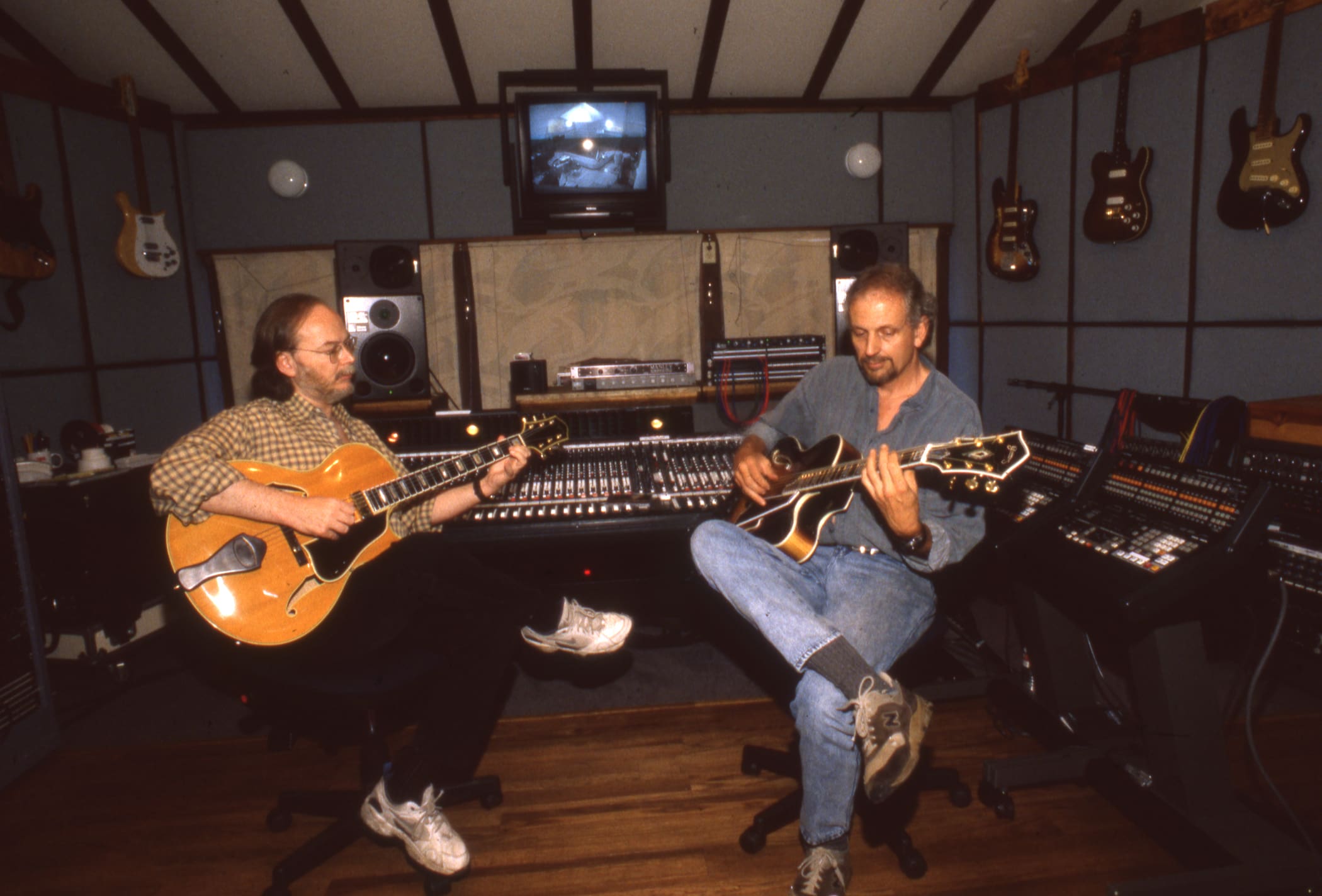
Above: Becker and Steve Grimes in Hawaii. Courtesy Steve Grimes.
Steve Grimes: He knew what he wanted. Oh my God, yeah.
Adam Grim: Walter knew he had money and he knew that people that are starting out businesses like myself don’t. Money was never an issue.
He never wanted to ask for a discount. In fact, most of the times, or any time money was even talked about, he didn’t want to even hear about that. If he went in a guitar store and found something that was by a small builder that he had never heard of, if he liked it, he’d buy it. And then he would sometimes do research and buy a second one because he liked that first one so much.
Ian Anderson: He really supported me. I’d have a guitar for sale, I’d call him up and he’d be like, “No problem. Send me the invoice for that.” He’d get the guitar and he’d really give me feedback on it.
Chihoe Hahn: He kept me alive for several years. He never custom-ordered from me. We would just talk,andif I had something that was different than what he had, I would let him know. And then he’d check it out and,say, pretty much inevitably, he bought it. We were just sort of exploring different things together. I think he actually bought an equal number of Teles and Strats. And then he started to get into my two new designs.
He was just open to what I came up with.
Nite Bob: Those Hahn guitars were played a lot. And I swear, there are guitars that he purchased that have never come out of the case.
Doug Kauer: He bought off the shelf and always paid full price. That made him the patron saint of guitar builders.
Top photo: Courtesy Satellite Amplifiers.
